"Why are you studying in the pottery?", enquired Paul Klee of Else Mögelin in 1921 after seeing her paintings of the village of Dornburg, home of the original Bauhaus Weimar pottery workshop, "these watercolours look as if they are designs for tapestries".
With Else Mögelin. Ich wollte, gegen alle Hindernisse, weben the Brandenburgisches Landesmuseum für moderne Kunst, Cottbus, explain and explore what happened next, and thereby help introduce an interesting and informative, if all too popularly anonymous, 20th century creative.......
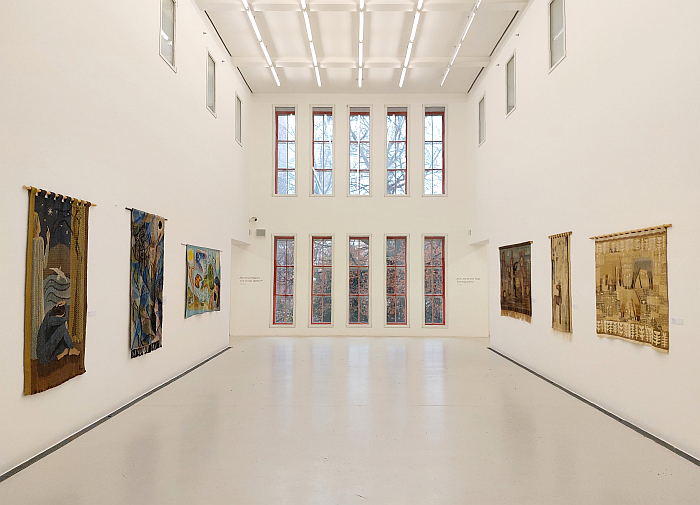
Born in Berlin on, by popular wisdom, April 21st 1887 as the scion of an established family of textile manufacturers and weavers, Else Mögelin initially trained as a Zeichenlehrerin, Drawing/Sketching Teacher, one of the regular courses of training undertaken by creatively inclined females in the Germany of that period... or more accurately, one of the very, very, few courses of training open to creatively inclined females in the Germany of that period... and worked as such in Berlin in the first decade of the 20th century. Parallel to her teaching Mögelin attended art classes by the Reform orientated painter Alfred Mohrbutter and also attended Interior Decoration classes at the Reimann School in Berlin, an institution, as previously noted, that was not only highly influential in the development of creativity, and creative education, in early 20th century Berlin, but which was an institution fully open to students of all genders before that was an actual thing in creative education in the contemporary Germany. Interior decoration classes at the Reimann School that saw Else Mögelin take up a position as a display window decorator, a, lest we forget, highly valued and painfully contemporary, profession in the early 20th century, with the textile manufacture and retailer F.V. Grünfeld; and a passion, and talent, for painting that saw her works exhibited at both the Berliner Secession and the breakaway Freie Secession Berlin.
In 1919 Else Mögelin swapped Berlin for Weimar and the newly opened Staatliche Bauhaus where, following completion of the Vorkurs under Johannes Itten and Paul Klee, she spent time in the metal workshop and pottery before, thanks partly to the council of Paul Klee, but also, one suspects, on account of her biography, she arrived in 1921 at the fabled Weimar weaving workshop where she spent some two years training under Helene Borner and Georg Muche. Training, and a biography, and passion for weaving, which she took with her in 1923 to Gildenhall, a settlement near Neuruppin, to the north of Berlin, where she helped establish a Reform orientated, arts and crafts, Artist/Handcraft Colony alongside numerous like-minded creatives. A Colony in Gildenhall that, as oft noted in these dispatches, is and was, as with Mögelin, a highly interesting and informative institution in context of developments in creativity of the inter-War period, if one that is all too often overlooked, not least on account of the popular Bauhaus focus, obsession, and an institution to which we shall return at a later date.
Against, one presumes, the background of the economic uncertainties, problems, crises, of the late 1920s, Else Mögelin swapped business for pedagogy in 1927, taking up the position of head of the Textile Class at the Kunstgewerbeschule in, then, Stettin, a position which also saw her cooperate with, design for, textile firms in the region, and thus remain very much a practising creative. Following the end of the 1939-1945 War, and with German Stettin now Polish Szczecin, Mögelin relocated to Hamburg, taking up the position as head of the Weaving Class at the Landeskunstschule, the direct predecessor of the contemporary Hamburg Hochschule für bildende Künste, a post-War refuge of numerous Bauhäusler, not least those seeking to escape the DDR; and a post Mögelin held until her retiral in 1952. Not that her retiral was one of inactivity, Else Mögelin continuing to weave and paint and travel extensively over the subsequent decades.
Else Mögelin died in Kiel on December 31st 1982, aged 95.

Our interest in Else Mögelin was very much awoken by the Brandenburgisches Landesmuseum für moderne Kunst's, BLMK's, 2019 exhibition Unknown Modernism, their contribution to the Bauhaus Weimar centenary year celebrations; an exhibition which explored the various and varied links between the contemporary Brandenburg and the Weimar Bauhaus, including presenting, amongst other Gildenhall works by Mögelin, textiles, clothing and an utterly joyous, and endearing, stuffed donkey; the latter a character whose ragamuffin appeal belies and belied the detail and care of its construction and composition. And which in doing so tended to highlight that Else Mögelin was and is much, much, more than just the rugs produced in the Weimar weaving workshop with which she is often associated. And a brief taste of the scope of Mögelin's oeuvre that very much implied there was a much fuller Else Mögelin exhibition out of there, waiting to be presented.
Ich wollte, gegen alle Hindernisse, weben, [In the face of all obstacles, I wanted to weave1], is, in many regards, that exhibition.
An exhibition that, more or less, opens with three of Mögelin's 1921 Dornburg paintings, those suggestions of the wisdom of a creative reorientation, before moving on to present a variety of Mögelin's works from across the periods and genres of her career. A presentation largely without comment; aside from a couple of brief biographic texts, and a guide to the singularities, and complexities, of the arts of weaving and tapestry, Ich wollte, gegen alle Hindernisse, weben is an essentially silent presentation, a format which through leaving you to reflect on and engage with the works on your own helps place the focus very much on the works and thereby, if one so will, employs the works of Else Mögelin as a path to Else Mögelin. As paths to Else Mögelin.
Paths laid out in Ich wollte, gegen alle Hindernisse, weben in a variety of media, if primarily gouache or wool. And often gouache and wool: the presentation of works such as Lanternkinder from ca. 1947 or the early 1960s works Licht und Schatten and Alpha und Omega as both the original 2D gouaches and as the subsequent 3D tapestries allowing one to better appreciate both how Mögelin approached and realised her weaving/tapestry and also the very close interplay between the various facets of her creativity. And, when you view the 1921 Dornburg paintings in context of Lanternkinder, Licht und Schatten or Alpha und Omega to appreciate that Paul Klee was very astute in his assessment of Mögelin's paintings as being more than paintings, and very wise in his council. An appreciation that is reinforced when you view works such as the ca. 1972 painting Am Lago Maggiore or Waagerechtes Spiel from ca. 1965, in context of the Dornburg paintings and Lanternkinder, Licht und Schatten or Alpha und Omega: for while the former are 2D works on paper you can well imagine them as 3D wool, for all Waagerechtespiel which is a utterly fascinating and endlessly engaging work. And also highly informative: although realised towards the end of Mögelin's career you can very much see it in Mögelin's 1921 paintings, thus allowing one, if at the risk of a truly unforgivable pun, to follow a thread through the periods and genres of her career. Sorry, but we couldn't not. It was there for the taking.
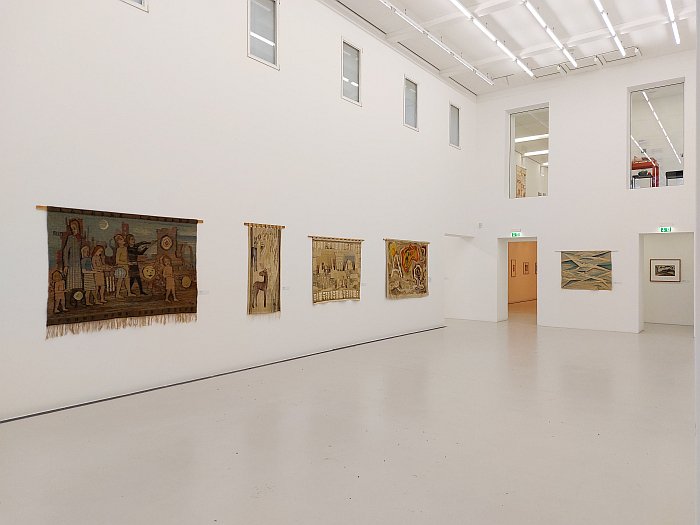
And while the stuffed donkey that we remember so fondly from Unknown Modernism isn't part of Ich wollte, gegen alle Hindernisse, weben, animals are, more or less, omnipresent, appearing in various forms and contexts through the periods and genres of Mögelin's career as explored in Ich wollte, gegen alle Hindernisse, weben. Including as a bast giraffe and a horse/rider combo that were also part of Unknown Modernism, but which we obviously overlooked then, arguably, looking back to our photos from then, on account of how they were presented, but which in Ich wollte, gegen alle Hindernisse, weben are without doubt one of the more engaging, fascinating, exhibits on show. And reminders, along with the other bast works by Mögelin, and photos of Mögelin's bast workshop in Gildenhall, of the popularity of bast in the inter-War years. A reminder that in the privations and material shortages of the early 20th century the woven fibre of native plant species was considered a genuine alternative to the numerous unavailable/limited materials. Something all to quickly forgotten when one views contemporary bast works, but which we should, arguably, urgently rediscover. In all contexts.
And an omnipresence of animals in Mögelin's oeuvre, and also a certain deftness of touch, Else Mögelin having a lovely way of depicting animals, see, for example, the lightness, communicativeness and vitality of her ca. 1948 weaving Grasende Pferde, Grazing Horses, that enables Ich wollte, gegen alle Hindernisse, weben to allow one to begin to appreciate Else Mögelin as a keen observer of nature, as an interested, involved, observer of nature, an observer of nature as more than just flora and fauna and weather, as more than just the tangible, a very contemporary observation at an early age.
And a presentation of a large number of works from across the many periods and genres of Else Mögelin's career that also allows one to approach an appreciation that Else Mögelin was not only a keen, involved, observer of nature, but also an observer of the human condition, of the needs and demands, physical and emotional, of the human species. Needs and demands that for all one can appreciate their associations and connections to the decades in which Mögelin explored them, we all share today, all experience today. And which Mögelin's work continue to mediate, respond to and engage with. Almost as if they were to be produced tomorrow.
If an observer of nature and of the human condition who at times drifts into the hazier, more detached and highly improbable, corners of esoteric. Or put another way, there is a regular naturalistic spirituality to be found in a great many of the works on show, to be found in the many impressions of humans and animals, of humans and nature, of the human world and the natural world in communion with one another, in a unity that transcends the physical worldly.
A naturalistic spirituality that reinforces the general impression given by the works on show of Else Mögelin as an individual with very strong, but not conservative, not ideological, Christian beliefs. Beliefs which in themselves aren't in any sense relevant, but, as we shall see, are not unimportant.

And an naturalistic spirituality that also links Else Mögelin to the more folkloric, and esoteric, elements of the NSDAP, and thus to that, arguably, most popularly known expression of the NSDAP's poisonous propaganda. A link to the NSDAP that in Mögelin's case was very real: Ich wollte, gegen alle Hindernisse, weben featuring the original etchings for a cycle of weavings Mögelin created for the Kraft durch Freude Hotel in Waldbröl, near Bonn, and thus for a hotel operated by an organisation who not only distributed the Volkswagen Beetle, helped make the Volkswagen Beetle the global success it is, but who also, if one so will, served as the NSDAP's official travel agency. If one more orientated to indoctrination than recreation. And a cycle of weavings by Mögelin which depicts the four seasons, each with a romantic, almost deliberately exaggerated naively, so, gaze, and in which each season is underscored not only by the respective state of development of the cycle of nature, but by a prominent rune; runes whose meaning sadly isn't explained, and our knowledge of NSDAP runes is, equally sadly, far too rudimentary to interpret them, but which we assume stand representative for some perceived Germanic/Aryan names for the seasons. Runes, as we all know, being an important, and ludicrous, part of the NSDAP's messaging, a component of their desperate seeking to underscore a link to a glorious Germanen past rather than approaching a meaningful global future.
And a link to the NSDAP that also stimulates one of the very few texts to be found in Ich wollte, gegen alle Hindernisse, weben; a text in which the curators note that Mögelin choose a path of minimum-resistance in context of the NSDAP, seeking, as much as possible, to keep well out their way, for example, spending most of the 1939-1945 War in the rural calm of north eastern Germany and thus far, far, from the realities of the Nazis' terror, and also adapting her style to suit the demands of the NSDAP, whereby, as previously noted, not least from Design of the Third Reich at Design Museum Den Bosch, ‘s-Hertogenbosch, and Power Space Violence. Planning and Building under National Socialism at the Akademie der Künste, Berlin, for all the popular focus on the NSDAP's use of national romantic, realist, esoteric, imagery they also happily employed the more Modernist positions they allegedly despised when it suited their nefarious needs, and so 'adapting' to the NSDAP was more a question of appreciating what was wanted in a given context rather than stylistic question per se.2 While also noting that for all Mögelin created works for the NSDAP, and didn't actively resist, and went along with their stylistic demands, much of what and who she was stood diametrically juxtaposed to the ideology and world view of the NSDAP. Quite aside from her, aforementioned, obvious strong Christian beliefs, her (presumed) homosexuality placing her very much in the ranks of those the NSDAP sought to, for want of a better phrase, remove from society. There was, in many regards, no place for an Else Mögelin in the NSDAP's world view.
Personal realities that of course don't automatically rule out that Else Mögelin supported other aspects of the NSDAP's world view, politics is a complicated aspect of any life, not least because political views form in contemporary contexts, but which do allow Else Mögelin to stand proxy for the tragically ever contemporary realities faced by creatives when denied access to their native society by prevailing political powers, and the question of how one responds: resistance, flight, silence or adaptation? Cooperation? And the associated question of how we judge the decisions those creatives make; or perhaps more accurately, the question if we are allowed to judge, criticise, support the decisions of an individual in a situation in which we don't find ourselves? And the other associated question of can, should, ¿must? the decisions any given creative makes influence how we subsequently view their work? For all when they are no loner around to discuss the questions involved.
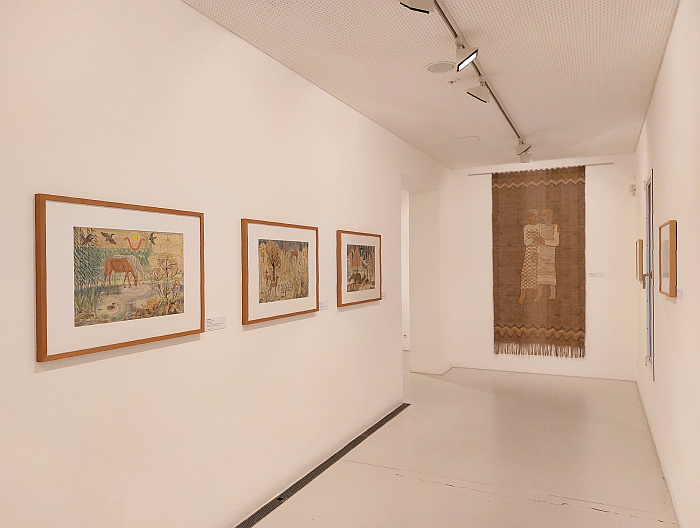
Featuring sketches, paintings, lithographs, clothing and textile works from across the many periods and genres of Else Mögelin's career, and the aforementioned 1924 bast giraffe and a horse/rider combo, Ich wollte, gegen alle Hindernisse, weben, for all its scope and range is still a relatively bijou exhibition, one that, as with Unknown Modernism, implies a much larger Else Mögelin exhibition is out there; is an exhibition that for all it allows one access to much better appreciations and understandings of Else Mögelin, her work, positions and approaches, taunts you that there is much more to learn and engage with. Approaches the fuller exhibition Unknown Modernism intimated, but still leaves you wanting more. If that 'more' is existent, or if it has long since fallen victim to the ravages of time and (hi)story, is another question; however, Ich wollte, gegen alle Hindernisse, weben very much demands that question be perused by us all.
But for all Ich wollte, gegen alle Hindernisse, weben very much demands that Else Mögelin be more regularly, and self-evidently, included in considerations and discussions on the development of creativity throughout the 20th century, introducing as it does a creative not bound by and to a single 'style' but who moved between various and varied forms of expression and artistic positions while always maintaining a readable individual signature, a creative with a firm idea of what she wanted to say and why, a creative with a confident, knowing use of colour as a structural medium as much as a decorative element, a creative with a view beyond the temporal, and a creative whose response to the questions of the first third of the 20th century regarding the provision and supply of our goods of daily use can inform contemporary discussions.
Is an exhibition that helps move Else Mögelin's biography not only far outwith the Bauhaus Weimar weaving workshop in which it is normally so firmly located, but out of the north eastern corner of the contemporary Germany, taking it to lands such as, for example, Italy, Greece or Israel, that were also important for Else Mögelin, personally and professionally; and also, and very, very, importantly, helps move Else Mögelin's biography into the second half of the 20th century and thereby, amongst many other important aspects, allows Else Mögelin to contribute to discussions on the development of art and craft in post-War West Germany as much as in pre-War Germany. And also to contribute to the discussion on the connections between the development of Christian art and of wider artistic positions in post-War western Europe. An admittedly rarely undertaken discussion, but not irrelevant for that fact.
Is an exhibition that allows Else Mögelin to contribute to explorations of and discourses on art and design under the NSDAP, the art and design of the NSDAP, and thereby to allow us all to better appreciate the realities of such not only in context of the NSDAP but in context of all totalitarian regimes. And also in context of all those wannabe totalitarian regimes of our current age.
If an exhibition that doesn't approach the obvious question posed in its title: Ich wollte, gegen alle Hindernisse, weben.
???
What was stopping you? Who said you shouldn't? Couldn't? If that was the case, why the teacher training? Which 'Hindernisse' stood in your way? How did you overcome them?
???
Such questions may, hopefully will, be approached in the forthcoming exhibition catalogue. And in many regards are questions for another day, are questions for once one has acquired the more probable appreciation of Else Mögelin Ich wollte, gegen alle Hindernisse, weben allows one to approach: an exhibition that while it doesn't explain why Else Mögelin wanted to weave does elegantly, entertainingly and accessibly explain that she could weave, and that we should all be thankful she did weave. And be thankful that Paul Klee saw in Else Mögelin's 1921 paintings of Dornburg more than just 2D depictions of a village in Thüringen.......
Else Mögelin. Ich wollte, gegen alle Hindernisse, weben is scheduled to run at the Brandenburgisches Landesmuseum für moderne Kunst, Dieselkraftwerk, Uferstraße/Am Amtsteich 15, 03046 Cottbus until Sunday March 3rd.
A catalogue is forthcoming, and from April 4th the exhibition will be on show at the Muzeum Narodowe, Szczecin, who are the co-producers.
Full details can be found at www.blmk.de
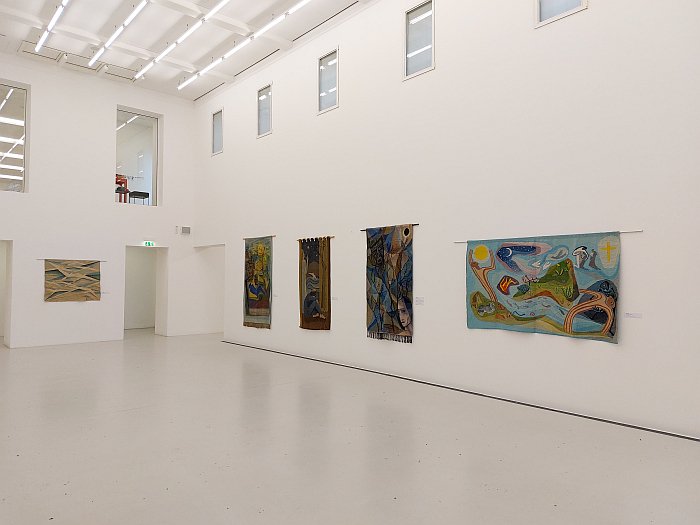

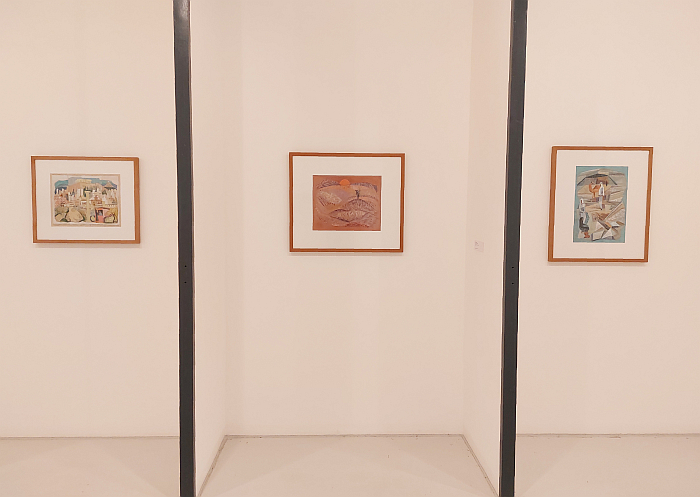
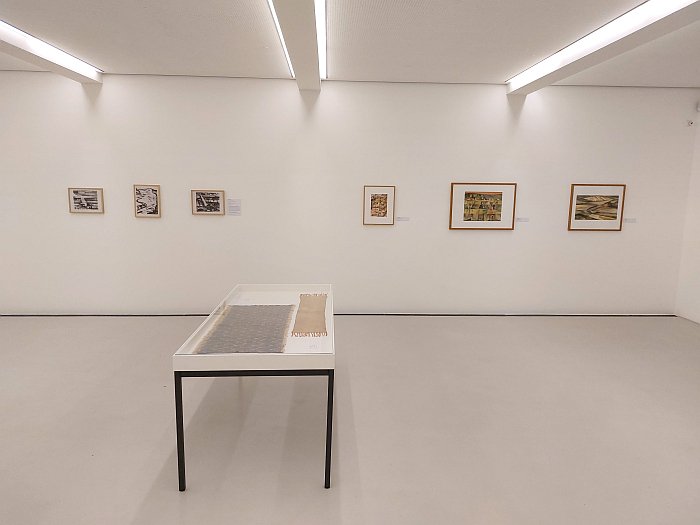

1The official English title is 'Else Mögelin. I Wanted to Weave Despite Adversity', which for our taste tends to read 'Hindernisse' as 'Widrigkeit/Unglück'. And while that may well be an interpretation that can be made when one reads the quote in its full context, that the quote isn't presented in the exhibition, and is only available in a document in the currently inaccessible depths of the Bauhaus Archiv Berlin, is not a reading we can make, and so we kind of have to stick with 'obstacles'. We are currently trying to source the original quote/text, once we have we may correct ourselves.......
2The curators also note that some of Mögelin's earlier works were entartet by the NSDAP, sadly without providing any more information. Such however is, we'd argue, important in understanding not only how Mögelin developed as an artist, but also in assessing in how far she adapted her style to the NSDAP. And in how far creating NSDAP compliant works was a component of a development she was in any case undertaking. And to understanding what was so problematic with the early works? What was she depicting? And how?